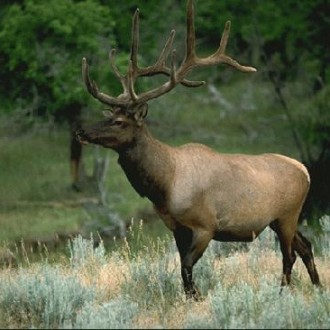


How to Draw an Elk
Please PAUSE the video after each step to draw at your own pace (scroll down to see the final elk drawing).
For the first few steps, don’t press down too hard with your pencil. Use light, smooth strokes to begin.
Step 1: Draw two circles as guides for the elk’s body. The circles don’t have to be perfect. They’re just guides. The circle on the right should be slightly smaller.
Step 2: Draw a smaller circle on the upper left side as a guide for the elk’s head. Pay close attention to the size of the circles and their spacing.
Step 3: Draw an arc on the left side of the elk’s head as a guide for the muzzle.
Step 4: Draw an even smaller arc on top of the elk’s head as a guide for the ear.
Step 5: Draw a long wavy line above the elk’s head as a guide for the antlers.
Step 6: Draw three more lines to the original line to complete the guide for the elk’s antlers.
Step 7: Draw four angled lines (two below each circle) as guides for the elk’s legs.
Step 8: Draw a series of curved lines that connect the circles to form the elk’s body.
That’s it for the initial sketch! From this point on, press harder with your pencil to get a more defined sketch.
Step 9: Draw the elk’s eye inside the head on the upper left side. The shape of the eye is similar to a football. Draw a circle inside and shade it in for the pupil. Draw a few lines around the elk’s eye for extra detail.
Step 10: Use the initial arc as a guide to draw the elk’s ears. Darken the outer line and draw a few lines within it to represent the fur inside. Draw a line for the other ear.
Step 11: Use the lines as guides to draw the elk’s antlers. First draw a curved line on the head as a base. Then thicken up the lines to create the antlers. Don’t make the antlers too thick or they’ll look like a moose’s antlers. The elk’s antlers should come to a point. Curve them a bit for a more organic feel.
Step 12: Draw the antler on the other side by using the first one as a guide. Most of the shape is hidden by the antler in the front, so only draw the visible spikes peeking from behind.
Step 13: Use the initial arc as a guide to draw the elk’s muzzle. The nose is made up of a curved line at the end of the muzzle with a shaded circle inside as the nostril. Draw a fuzzy line that extends toward the circle for the mouth.
Step 14: Draw the rest of the elk’s head using quick, short strokes to represent fur. Draw some lines within the head for extra detail.
Step 15: Using the initial lines as guides, draw the long, think front legs. The top of the leg should be thicker. Draw a line at the bottom to split the cloven hoof. Draw lightly at first to get the shape right. When you’re happy with what you have, go ahead and darken it. Draw the leg on the other side the same way as the first. Draw lightly at first. Make the top thicker and split the cloven hoof.
Step 16: Use the initial lines as guides to draw the elk’s hind legs. Draw the hind legs the same way you drew the front. The top part is a bit thicker and have the top joint come out more to create the hock. Now draw the leg on the other side using the same technique.
Step 17: Use the initial lines as guides to draw the elk’s body. Use quick, short strokes on the bottom to represent the shaggy coat underneath and along the elk’s neck.
Step 18 (optional): You can stop here for a sketchy look or erase as much as you can of the initial guide lines for a cleaner look. Don’t worry about erasing all of them. It’s okay to leave some behind. Also re-draw any final sketch lines that you may have accidentally erased.
Step 19 (optional): Add some shading to your drawing to give it more dimension and volume. Pick the direction of the light source when shading so that the shadows are consistent with it. Vary the pressure on your pencil to get different degrees of tonal value. Add a cast shadow underneath. This helps ground the elk so it doesn’t appear to be floating.
Step 20 (optional): You can add more value throughout your drawing for extra detail. The neck and legs are usually darker than the rest of the elk’s coat. It’s a good idea to use reference to be as accurate as possible. Remember to PAUSE the video any time you need help along the way.


 (1 votes, average: 4.00 out of 5)
(1 votes, average: 4.00 out of 5)